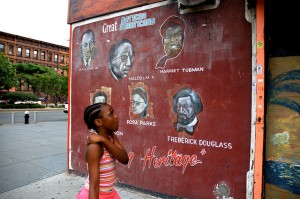
Every day the Metropolitan Tenants Organization works with renters who are facing the negative effects of gentrification and other economic forces that threaten their housing. Thousands of low-income renters and homeowners are displaced every year by a property law system with misplaced priorities. As a society, we all pay when people are involuntarily displaced because of increased crime, skyrocketing medical costs and a failing educational system. It is imperative that as a nation we confront this housing crisis and ensure that everyone has a home.
The insights of visionary Black leader Malcolm X, who would have been 91 this year, are key to the discussion around gentrification and housing. Malcolm X championed a new vision, reframing the character of the struggle for equality from civil rights to one of human rights. He also raised the concept of self-determination as essential to any struggle for equality. I want to use the lens of human rights and self-determination to contextualize gentrification and look for solutions to the nation’s housing crisis.
The foundation of current gentrification can be traced to the very beginning of the United States.
What is gentrification? From the perspective of the community members, gentrification is the loss of community (and individual) control over the land they live on, a forced displacement of residents from their homes and their communities. It generally occurs in low-income neighborhoods in which people of color reside. Gentrification is not a haphazard process that happens by accident. It is systemic in nature and sanctioned by a faulty legal system.
Gentrification is not just a modern-day occurrence. The foundation of current gentrification can be traced to the very beginning of the United States. In 1823, the US Supreme Court in Johnson v. McIntosh legitimized the concept of ownership through conquest. In Johnson, the Court held that “savages” (the Court’s term for Native Americans) had no right to sell or control the land because the land was “discovered” by settlers. Only the US government could give Native people the right to sell or transfer the land.
The case is important to understanding gentrification because the Court declared that the indigenous population does not have any inherent right to determine the use of their land. In this case, the Court ruled that the colonization of the continent had in fact erased the slate and thus nullified any Native people’s claims to the land. It made the government the sole arbiter of sale or transfer of land. At the same time, it legitimized the government’s use of force to take over the continent and gain control of indigenous people’s land.
Furthermore, the Court’s opinion is indicative of the primary role that race plays in community development. The Court called indigenous people “savages.” Intrinsic in this name-calling is the idea that Native Americans are the “other” – that European culture is superior – and that as an inferior community, they could not possibly make good decisions as to how they use their land. This inherently wrong, racist decision enshrines the legal and conceptual basis of gentrification, or what I have called ownership through conquest.
Many of the first people to move into a changing neighborhood are described as “pioneers.”
If we look at what is happening today in major cities throughout the United States, the same principles and legal precepts are at work. Now, instead of military might, overpowering economic forces are pushing low-income people of color out of their neighborhoods and often out of the cities and into the suburbs. This is happening because public and private investments in the downtown business core have made these areas extremely important and valuable. As the core of the city expands, the neighborhoods that abut the downtown area and those along transportation lines leading to downtown have dramatically increased in value.
Investors and their partners in the public institutions have “discovered” these communities and swooped in to take control of abandoned and vacant properties, at first; but soon all properties in these neighborhoods become targets for takeover. The outside investors then develop the land to fit the needs of the downtown elite. They build new and high-cost apartments and high-rises and demolish and get rid of properties suitable for people of more modest means. Many of the first people to move into a changing neighborhood are described as “pioneers,” the same term used to refer to the initial invaders of North America who imposed the White man’s ways on the Native peoples.
This means families who have often lived in these neighborhoods for decades are forced to relocate. Tenants in particular, because of the lack of a secure tenure, face an onslaught of economic pressures to move. Outside investors will often close buildings and evict all the tenants as they develop properties to cater to wealthier non-community members in an effort to get them to move into the community. Tenants are then forced to find and move into an ever-shrinking supply of affordable housing.
At the same time, landlords are increasing the rent as the neighborhood becomes “hot.” In the end, the vast majority of the tenants will be forced out. It is beyond their means to resist these economic forces on their own. For instance, in Chicago, more than 50 percent of tenants are rent burdened, meaning more than one-third of their income goes to housing costs. Obviously, when tenants are barely able to pay rent, any changes in rent, job status or medical situations will result in displacement.
It is not only renters who face challenges. In the case of homeowners, many long-time residents are losing their properties to foreclosure or seeing dramatic increases in their property taxes, which once again force them out. The current gentrification of US cities is an economic conquest backed up by the courts.
The current gentrification of US cities is an economic conquest backed up by the courts.
Many of the same racist justifications for this conquest are still at play today. Gentrification is often explained away as a needed phenomenon. The community “needs” the often White and well-to-do invaders to move into the neighborhood to improve it. In other words, the current residents are not “invested” in the neighborhood, as they are “not good enough” to develop it on their own. The local culture is destroyed as new, wealthier people flood into a community. The newcomers take over all elements of the community, bringing in their own “superior” culture, such as more expensive restaurants and entertainment venues. This escalates and expands the dislocation to include existing businesses. It is all legal, built on decades of laws based on the rights of the powerful few and not on the human rights of the many.
It is for this reason that Malcolm X’s vision of moving toward a struggle for human rights is so important. Housing is a basic human necessity that any individual needs in order to enjoy life, liberty and the pursuit of happiness. Without a home, it is next to impossible to find work, to educate your children and to better your conditions. Housing needs to be made into a human right, a right protected by law.
What would it mean if housing was a human right? It certainly means more than just ensuring a roof over one’s head. It means making sure that everyone has decent, safe and accessible housing. It is hardly a home if that home does not have heat during the winter, or is infested with mold and other pests. Housing needs to be affordable. If housing becomes so expensive that a person needs to decide whether to eat or pay the rent, then they will always be at risk of losing their housing. Housing also needs to be stable. People should be able to choose where they live. No one should be forced to move just because someone else wants to live there.
So, how can we change policies and begin moving toward a human rights framework based on community needs, as it relates to gentrification? To begin with, we could implement:
- Laws to end lockouts, self-help evictions outside of the legal system: No tenant or homeowner should lose their home without due process.
- Mandatory inspections laws: Municipalities and other government agencies need to be responsible for ensuring that all residential properties meet certain codes of health and safety.
- Just cause laws: A property owner should be required to have a justifiable reason to evict a resident. No one should have their tenure interrupted because of discrimination, retaliation or any other unfair reason.
- Laws to limit foreclosures: Banks and other agencies ought to be held accountable for their actions in creating the housing crisis.
- Property tax laws: Property tax laws should promote stability. Tie property taxes to the purchase price of buildings, which would help keep taxes affordable for long-term residents and in addition provide low-income residents with tax relief.
- Rent controls: This can take two forms. Rent increases could be regulated by law to give current tenants the opportunity to continue to live in their homes. Or secondly, current residents could receive a rental subsidy to make up for the increase in rent due to gentrification.
- Create community-based zoning boards: These boards can regulate zoning changes and give communities control over development.
- Create eviction-free zones: Activists and legal services providers work to prevent any eviction in these areas of gentrification to slow down the development process and challenge the investor-invaders’ assumption that they can do what they want.
All these potential policies and actions can begin to ameliorate the effects of gentrification and provide communities with a legal and moral basis to fight gentrification and promote housing stability. No one should be forced to move from their home against their will.
Adopting a human rights framework can provide individuals and communities with new tools and perspectives that offer the hope of ensuring that everyone has the right to secure safe, decent and accessible housing that is affordable. Defining housing as a human right allows for an expansive outlook that goes beyond viewing housing as merely a roof over one’s head or a commodity for sale. A human rights framework will benefit the majority and move society onto a path of social equity. As Malcolm X said, “I’m for truth, no matter who tells it. I’m for justice, no matter who it is for or against. I’m a human being, first and foremost, and as such I’m for whoever and whatever benefits humanity as a whole.”
——————————————————————————————————————————————-

John Bartlett is the executive director of the Metropolitan Tenants Organization. John is a dedicated social justice advocate who has spent decades fighting to protect people’s homes and environment. John’s expertise and experience – from civil disobedience to landlord-tenant mediation – has proved irreplaceable in Chicago’s continued fight for affordable housing.
This article was originally published in TruthOut.